Phase Two - Putting it into Practice
We have laid the foundation for inclusive education. Now is the time to identify specific students with significant cognitive disabilities and complex access needs to begin moving toward a more inclusive setting. The team must decide when they feel comfortable and prepared enough to enter Phase Two. Phase Two relies on intense team collaboration and critical problem-solving as each school has their own unique procedures and resources that will need to be addressed, integrated, and adapted to create systems change.
When transitioning a student from a self-contained to a general education setting, the team will find that each student’s new general education classroom is also a unique mix of staff, students, activities, and curriculum. There will be staff and student-specific training needs that emerge during the transition. This should be addressed here during Phase Two, integrating more concentrated professional development on the specialized structures and supports needed to move students with the most significant cognitive disabilities and complex access needs into a general education setting.
The Coach Should Assist the Team to:
- Continue to meet twice-monthly for the entire school year. Meetings should have a detailed agenda.

Significant Cognitive Disabilities, Inclusion
Inclusive Education Team Meeting Agenda/Minutes
This blank agenda template can be used to prepare for an inclusive education implementation team meeting.
- Continue to monitor growth by completing the fidelity checklists for Fundamentals of Inclusive Education and Presuming Competence, as well as any additional fidelity checklists or rubrics corresponding with professional development the team may have incorporated into their action items (such as Building a Foundation, Transitioning a Student, Supports for Participation, Universal Design for Learning [UDL], Accessible Instructional Materials [AIM], A Step Toward IEP Quality and Rigor, or Creating and Sustaining Peer Networks).
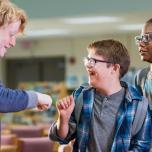
Significant Cognitive Disabilities, Inclusion
The Fundamentals of Inclusive Education for Students with Complex Access Needs
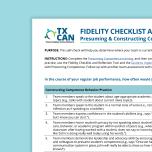
Significant Cognitive Disabilities, Inclusion
Fidelity Checklist and Reflection Tool: Presuming and Constructing Competence
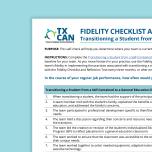
Significant Cognitive Disabilities, Inclusion, Transition
Fidelity Checklist and Reflection Tool: Transitioning a Student from a Self-Contained to a General Education Classroom
This self-check will help you determine where your team is currently performing in regard to transitioning students with complex access needs for inclusion. Complete the Transitioning a Student from a Self-Contained to a General Education Classroom training and then complete this document to get the
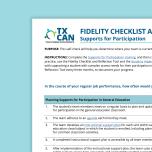
Significant Cognitive Disabilities, Inclusion, Instruction
Fidelity Checklist and Reflection Tool: Supports for Participation
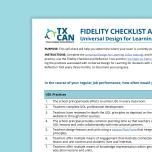
Significant Cognitive Disabilities, Inclusion, Instruction
Fidelity Checklist and Reflection Tool: Universal Design for Learning (UDL)
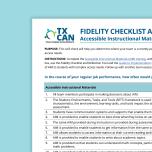
Significant Cognitive Disabilities, Inclusion, Instruction
Fidelity Checklist and Reflection Tool: Accessible Instructional Materials (AIM)
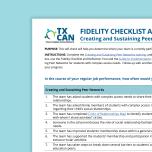
Significant Cognitive Disabilities, Inclusion
Fidelity Checklist and Reflection Tool: Creating and Sustaining Peer Networks

Significant Cognitive Disabilities, Behavior, Instruction, ARD/IEP Supports, Inclusion
Rubric of Effective Practices for Students with Complex Access Needs

Significant Cognitive Disabilities, ARD/IEP Supports
IEP Quality and Rigor Rubric
- Use student data to monitor the effectiveness of supports and inclusive practices.
- Revise Inclusive Education Implementation Plan action items as needed to increase fidelity.
- Identify specific students to begin transitioning to a general education classroom.
- Adjust members of the inclusive education implementation team as needed.
- Each individual student has their own support team (e.g., members of their Admission, Review, and Dismissal Committee, additional campus staff, and other people from the student's relationship circle). Guide these individual student teams in planning supports for student participation in general education, using the Instructional Support Planning Form. Keep the team on track with an Instructional Support Planning Meeting Agenda.
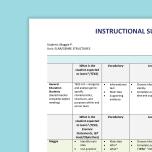
Significant Cognitive Disabilities, Inclusion, Instruction
Instructional Support Planning Form
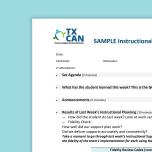
Significant Cognitive Disabilities, Inclusion, Instruction
Instructional Support Meeting Agenda Template
- Facilitate peer support networks for isolated students.
- Recognize staff and student-specific training needs and have appropriate staff engage in this professional development.
- Plan for long-term sustainability of programs and resources.
Identifying Students for Transition
To identify the students for transition, the team may look at a variety of data, such as notes from classroom observations in the student’s current setting, Individualized Education Program (IEP) reviews, report cards, state assessment results, family observations and input, and student relationships.
A TX CAN training you may find helpful for Identifying Students for Transition: Transitioning a Student from a Self-Contained to a General Education Classroom.
Planning Supports and Facilitating Peer Support Networks
Whether transitioning one student or multiple students, the team should carefully study each student's participation in their special education setting and compare that to how peers participate in classroom activities in the general education classroom. This will enable the team to identify similarities, differences, and needs as they plan for transition. The team should also look at each student's unique relationships across environments.
The team should designate one individual to serve as each student’s team leader, or Inclusion Facilitator. This person will lead the student’s individual team through Instructional Support Planning meetings, using an Instructional Support Planning Form with an Instructional Support Planning Meeting Agenda, and coordinate the provision of supports and friendship facilitation for the student.
Using the principles of Universal Design for Learning and incorporating accessible instructional materials and assistive technology when applicable, the team will address supports for each general education class and extracurricular activity for which the student will participate.
By evaluating the depth and breadth of student relationships, the team will help to remove relationship barriers then create and sustain peer support networks for students who may be lonely, isolated, or who have small social circles. A Circle of Relationships Map can help you explore those student relationships.
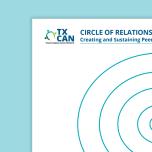
Significant Cognitive Disabilities, Inclusion
Circle of Relationships Map
This map helps a team explore student relationships.
Based on the unique needs of the team, or individual staff members, you may assign related professional development by selecting from these TX CAN trainings that align to Planning Supports and Facilitating Peer Relationships:
Barriers/Coaching Tips
Many educators may believe in inclusive education but are still unsure about the steps to take to move students with significant cognitive disabilities and the most complex access needs from self-contained settings into general education classrooms. They may be hesitant and fearful of change in general.
- Reassure staff that feeling overwhelmed is normal and that starting small (with one student, for example) will allow staff to identify problems early and permit them to adapt and adjust procedures before they move their processes to a larger scale for whole school change.
- Help staff to define the supports needed for transition.
- During this phase, it may be beneficial to set up discussions or visits to schools that are further along in their inclusive efforts. Creating professional-to-professional conversations may help allay staff fears about implementation. Experienced inclusive educators can reassure staff that uncertainty is a common feeling during this phase and can encourage them to proactively problem-solve issues.
During this phase, teams are likely to want to quickly see student progress as an indicator that “inclusion works.” Stress to teams that during this phase, they are focusing on doing the work of “Putting It into Practice” - improving the fidelity of supports they are providing for students to be successful in the general education classroom. It is a time for student and staff need-specific professional development, particularly with respect to the provision of high-quality curricular adaptations, assistive technology, and augmentative communication.
Coaching strategies that are effective during this phase include:
- Coaches can model effective inclusive practices by going into the classroom themselves to support the student while select student team members observe.
- Videotape coach's modeled instruction and debrief with the student’s team. If the coach is willing to be vulnerable and critical about her own practice it can build trust and credibility with the team.
- Continue to build student support networks. Students and their peers often have creative solutions to problems that adults have difficulty solving. They can also provide an honest and transparent lens through which to view these initial inclusive efforts.
Because this phase involves the implementation of new practices and extensive team collaboration, coaches may find themselves dealing with difficult team members. These are not usually individuals who are “against inclusion”, but team members who may feel that their professional expertise is not being respected or who overall find change challenging. Coaches can handle these situations through relationship-building, referencing team roles, responsibilities, and meeting norms, using listening and inquiry practices, and addressing questions and problems early, rather than “seeing how it plays out” later. Refer to the meeting structures, processes, and skills from the Coaching and Team Meeting Basics for Inclusive Education course as needed.
